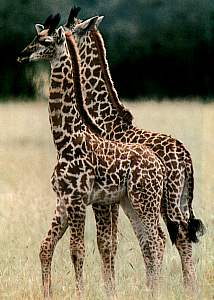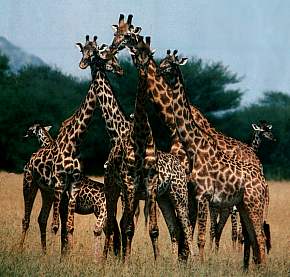| Both partners play active roles in a secure base relationship. Moreover, their behavior does not exist in isolation; it has to be coordinated with other important behavioral systems and strategies. Human secure base behavior takes on a special fascination when it is viewed in the context of secure base patterns in other species. This was one of John Bowlby's best insights, and probably more true than he knew. Take giraffes for example ... | |
| Many hoofed species hide their young for the first 1-4 weeks of life. Giraffes follow this pattern but are unusual in their willingness to roam as far as 15 miles from the calf in search of food and water and in extending the hiding period for up to a year. This has earned giraffes a reputation for being poor mothers. In fact, this is not neglect but an elegant accommodation between two imperatives: safety from predators and survival in a hot dry climate. |
|
| For the first month, the calf is hidden away from all
other giraffes. The mother returns 2-3 times a day to feed it. After this period, the
mother returns each morning to feed the infant and then leads it to an area where they
join other females and calves. By mid-morning all the females have wandered away and the
hidden "nursery" is unguarded. Soon however, the situation resembles a rotating
baby-sitting system. The mothers wander off in the morning but one "guardian"
(typically a different mother each day) stays with the "nursery" all day. In the
evening, all the mothers return and stay with their calves, protecting them from predators
through the night. Why do female giraffes abandon their infants for so much of the day over so many months?
|
|
| Vaughan A. Langman (Smithsonian, Jan. 1982, pp. 94-103)
suggests that this unusual pattern of infant care is an accommodation to life in the hot
dry African plains. Many warm-blooded animals control their body temperature by sweating
or panting. This is effective but can use enormous amounts of water. Like camels, giraffes
neither pant nor sweat. Instead they allow their body temperature to rise 3-10 degrees C.
during the day and get rid of the heat into the cool night air. Of course there is a limit beyond which hot becomes too hot. But if you weigh 600-3,000 pounds you heat up pretty slowly. And there's the rub - the giraffe's physiological strategy for conserving water by not strictly controlling body temperature only works for adult giraffes. A small giraffe exposed to direct sun would heat up to dangerous levels. Until they weigh 600 pounds or more, they have to stay in the shade much of the day. This explains a lot: Why cache the young together? There aren't enough shady places for each mother and infant to have their own, so many mothers and infants congregate where shade can be found. Why not have mothers stay with their calves? If all the mothers stayed with their calves throughout the day, they would eat every green leaf in sight - no more food and no more shade. It is far better that they forage elsewhere. Why does this daily separation go on for so many months? Because that is how long it takes the calves to grow large enough to safely use the passive heat regulation strategy. All you need to make this work is a few adjustments to the standard secure base arrangement: (1) infants have to stay put or together, not go looking for mother, (2) the presence of another female has to make the mothers comfortable enough to leave their calves and (3) the calves have to follow any female who is leading her own calf to safety. It is interesting to think of secure base behavior as a pattern or framework that evolution can work with. Ask yourself, "What kind of thing is this that evolution is working with?" |
|
|
As Bowlby pointed out, proper understanding of secure base behavior
involves placing it in comparative/evolutionary and developmental perspective and in the
context of other behavioral systems. Properly understood, our secure base behavior is probably as interesting as a giraffe's. But then it would have to be. |
Gallery Home


